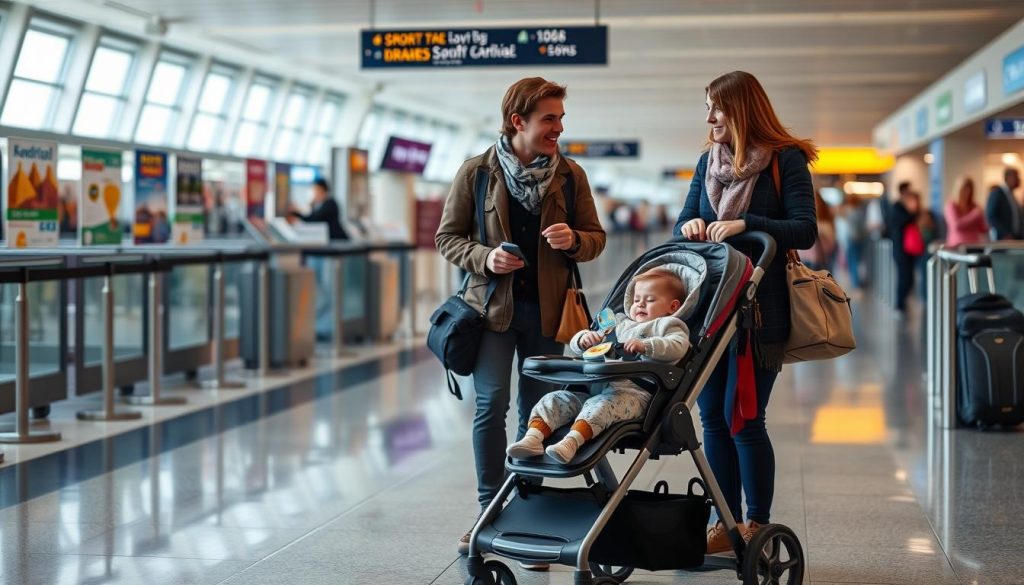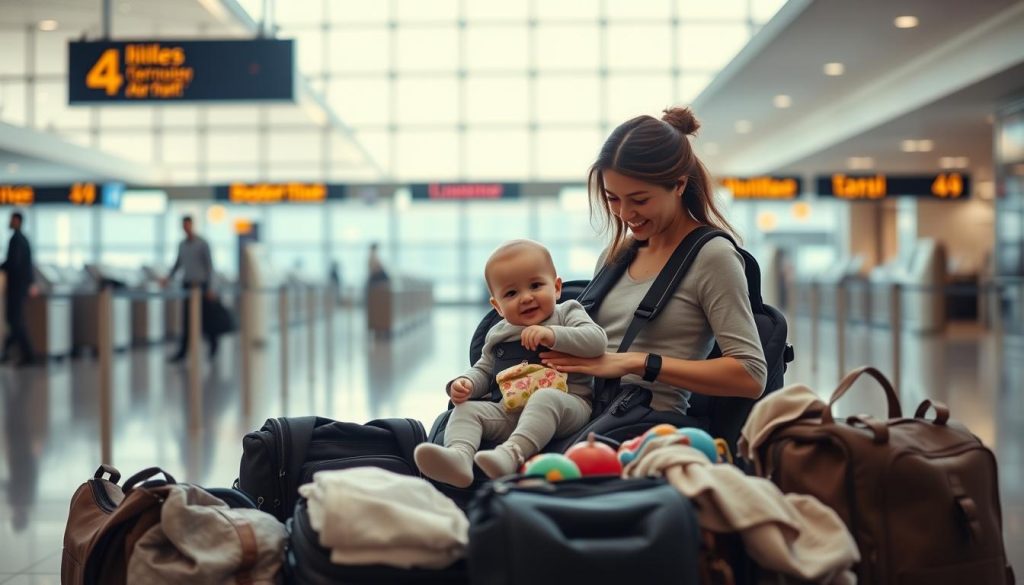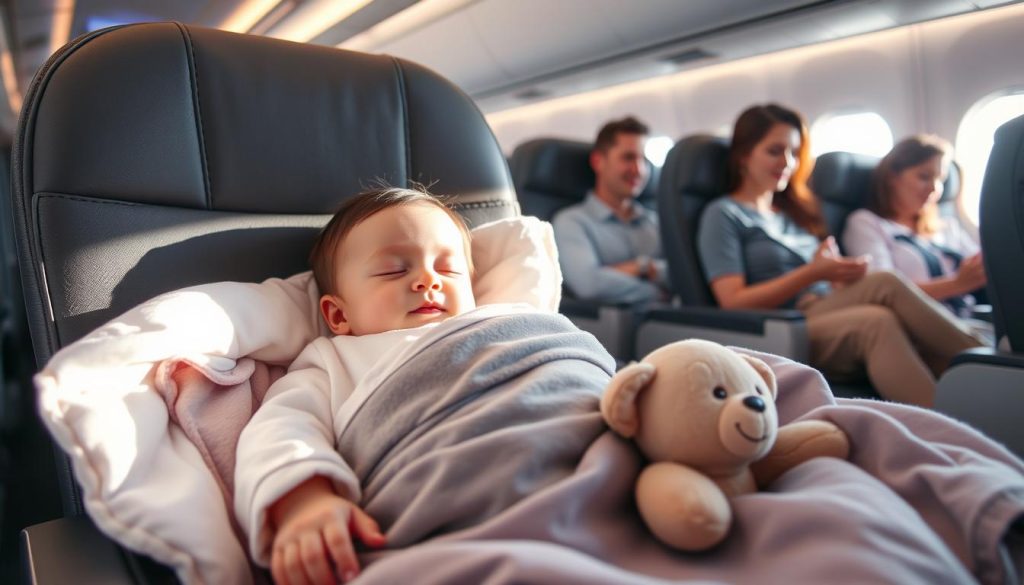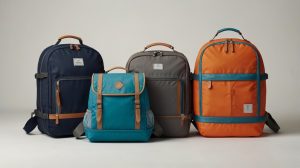
Traveling with a baby can be both rewarding and challenging for parents. Whether it’s a family vacation or a work trip, planning for infant travel is key. This guide will share eleven vital tips for a stress-free journey with your baby.
We’ll cover everything from pre-flight planning to in-flight comfort and safety. Our advice comes from real experiences and expert tips. You’ll learn how to pack, manage sleep, and more, making your travel smoother and more fun.
Key Takeaways
- Plan for unexpected delays and bring extra supplies when traveling with a baby
- Carefully research airline policies and choose flights that align with your baby’s schedule
- Pack essential items for comfort and convenience, including clothing, feeding accessories, and emergency supplies
- Prioritize in-flight safety and comfort by utilizing car seats, bassinets, and other travel gear
- Develop strategies to manage feeding, hydration, sleep, and jet lag during your journey
1. Pre-Flight Planning Essentials
Getting ready for a trip with your baby needs careful planning. Pick flight times that match your baby’s sleep schedule. Try for an early morning flight, like 7:00 a.m., for an 11:30 a.m. departure. This can help your baby under 1 feel rested and comfortable during the flight.
Also, look into airline policies on infant travel gear. Some airlines give discounts for kids under 2 on a parent’s lap. Others might need a separate seat. Know what documents you need, like birth certificates or passports for international trips. Knowing the rules for formula, breast milk, and baby food makes going through security easier.
Choosing Flight Times and Schedules
- Aim for an early morning departure, around 7:00 a.m., for an 11:30 a.m. flight
- Time the flight to align with your baby’s sleep schedule for a more comfortable journey
Documentation Requirements
- Ensure you have a birth certificate or passport for your baby under 1 for international travel
- Review airline policies regarding documentation for infants and traveling with baby
Airline Policy Research
Learn about the airline’s rules for baby travel gear, including:
- Discounts for children under 2 flying on a parent’s lap
- Allowed items such as formula, breast milk, and baby food
Good preparation makes traveling with your baby to Disneyland or elsewhere easier and less stressful.

2. Traveling With A Baby: Core Strategies
Traveling with a baby needs careful planning. It’s important to set realistic goals and keep routines familiar. Vacations with babies are more about adjusting to new places than relaxing.
Start with short trips to help your baby get used to travel. This helps you find and fix any problems early. Also, choose vacation rentals for a cozy, home-like feel.
Use airline perks for free stroller and car seat check-ins. This makes airport travel easier and keeps your baby’s gear ready. With good planning, you can enjoy your trip more and make lasting memories.

“The key to successful traveling with baby is flexibility, patience, and a willingness to adapt to your child’s needs. With the right mindset and preparation, you can turn your family vacation into a joyful adventure.”
Traveling with baby is all about finding the right balance. Be ready for challenges and make the most of your journey. This way, you’ll have a trip your whole family will remember.
3. Smart Packing Solutions for Baby Travel
Traveling with a baby needs careful planning and smart packing. It’s important to pack the right items without overloading your luggage. Using packing cubes and organizing your bags can make a big difference.
Essential Items for Carry-on
Your carry-on should have everything your baby needs. Include their favorite toys, blankets, and pacifier to keep them calm. Pack clothes that are easy to change and travel-sized toiletries and snacks.
Also, remember a first-aid kit with medications and emergency contact info. This will help you be ready for anything.
Clothing and Comfort Items
Choose clothes for your baby that can be layered. This makes it easy to adjust to changing temperatures. Bring extra outfits for you and your baby, just in case.
A portable changing pad and lots of diapers, wipes, and bags are must-haves. They help you stay prepared for any mess.
Emergency Supplies
Make a detailed emergency kit for your baby. Include a first-aid kit with bandages and ointments, and any needed medications. Also, pack a change of clothes for you and your baby.
A portable white noise machine or humidifier can help your baby sleep well. A lightweight stroller or baby carrier is great for moving around airports and exploring new places.
By making a thoughtful packing list and using smart packing tips, you can reduce stress. This lets you enjoy making memories with your baby. Remember, traveling light is key to a successful trip.
4. Navigation Through Airports With Infants
Traveling with a traveling with baby stroller, baby traveling kit, and traveling with baby gear can be tough for parents. But, with some planning, you can make the trip easier and less stressful.
Choose a lightweight, compact traveling with baby stroller that fits in overhead bins or can be gate-checked. Use a baby traveling kit for easy movement through security and boarding. Look for family-friendly security lanes and take advantage of pre-boarding, as airlines let families with infants under 2 board first.
Some airports, like Detroit and Chicago O’Hare, have play areas for toddlers. This can be a big help during layovers or delays. Pack your baby traveling kit smartly, keeping important items like diapers, wipes, and snacks easy to find.
- Carry a form of identification for your child to avoid issues at the boarding gate.
- Book your ticket with the “infant in lap” option, marked as “INF” on the ticket.
- Get to the airport 2-3 hours before your flight for security checks, diaper changes, and unexpected delays.
Stay calm and plan for extra time to get through the airport with your baby. With some preparation and a positive attitude, you can make the traveling with baby photos journey smooth.
“Traveling with a baby requires patience, but the rewards of experiencing the world with your little one are priceless.”
5. Car Seat and Stroller Management
Traveling with a baby means you need to handle car seats and strollers carefully. This is for safety and to make things easier. Here are some key tips to help you out.
Gate Checking Options
For air travel, use an FAA-approved car seat for your baby. It’s the safest way to keep them safe during flights. Gate-checking your stroller makes it easy to get it when you arrive.
Installation Tips for Rental Cars
Know how to install a car seat in a rental car. The Cosco Scenera car seat is light and affordable. Make sure it fits well to keep your baby safe.
Storage Solutions During Flight
Keep your important items in bags under the seat in front of you. Use a travel bag or cover for your stroller or car seat if you’re checking them. Always check your car seat is installed right before driving.
Cosco Scenera Next Travel Car Seat
- – 6.8 pounds
- – Affordable, lightweight, FAA-approved
- – 15 pounds
- – Portable, functional, suitable for toddlers
JetKids CloudSleeper Toddler Travel Bed
- – Designed for children up to 6-7 years old
“Crash tests indicate that children restrained in FAA-approved car seats are more likely to survive and avoid serious injury.”
Managing your car seat and stroller well makes traveling safer and smoother for your baby. Always check airline rules, pack smart, and put your baby’s safety first.
6. In-Flight Comfort and Safety
Traveling with a baby on a plane can be a unique challenge. But with the right planning and preparation, you can make sure your baby is comfortable and safe. Dress your baby in cozy, layered clothing that can be adjusted as the cabin temperature changes.
During takeoff and landing, encourage your baby to suckle on a bottle, breastfeed, or use a pacifier. This helps equalize the air pressure in their ears, preventing discomfort. Also, keep a soft blanket handy for warmth and for stretching and playtime.
- Pack a small kit with essentials for diaper changes, such as wipes, clean diapers, and a changing pad, to make in-flight adjustments a breeze.
- Bring along engaging entertainment like soft toys, board books, or a tablet loaded with age-appropriate shows to keep your baby occupied and content.
- If possible, book a bassinet seat for long-haul flights, as this provides a safe and comfortable sleeping space for your infant.
Anticipating your baby’s needs and packing the right supplies can make flying more relaxed and enjoyable for everyone. Remember, flight attendants are often eager to help parents traveling with little ones. So, don’t hesitate to ask for assistance when needed.
| Tip | Benefit |
|---|---|
| Dress baby in comfortable, layered clothing | Allows for easy temperature adjustments during the flight |
| Encourage suckling during takeoff and landing | Helps equalize ear pressure and prevent discomfort |
| Pack a diaper change kit | Makes in-flight adjustments more convenient and mess-free |
| Bring engaging entertainment | Keeps your baby occupied and content throughout the flight |
| Book a bassinet seat (if available) | Provides a safe and comfortable sleeping space for your infant |
By following these tips, you can ensure a more comfortable and stress-free flying with a baby experience for your little one and the entire family.
7. Feeding and Hydration During Travel
Traveling with a baby can be challenging, but it’s doable with the right tips. Whether you’re using bottles, formula, or introducing solids, these suggestions will help. They’ll make sure your baby stays nourished and happy during the trip.
Bottle and Formula Management
For formula-fed babies, pack ready-to-use formula or pre-measured powder in separate containers. The TSA lets you bring formula and breast milk in amounts over 3.4 ounces. This means you can have enough for your journey.
Remember, powdered formula stays safe at room temperature for only two hours. So, plan your feeding times carefully. Ready-to-feed formula needs to be refrigerated after opening and used within 48 hours.
Breastfeeding Tips While Flying
Breastfeeding on the go is convenient during travel. Carry nursing pads and a nursing cover for privacy. If you need to pump, bring all your equipment, including power adapters.
The Friendly Airports for Mothers (FAM) Act requires airports to have private spaces for expressing breast milk. This makes breastfeeding easier while traveling.
Snack Strategies
For babies on solids, pack enough food for the trip and extra in case of delays. Bring bibs, spoons, and forks for feeding. Reusable food pouches can also be handy.
Stay hydrated yourself and offer your baby small feeds often during the trip. This keeps them comfortable and happy.
| Feeding Essentials | Tips |
|---|---|
| Bottles and formula | – Pack ready-to-use formula or pre-measured powder – TSA allows formula and breast milk in quantities exceeding 3.4 ounces – Powdered formula is safe at room temperature for only two hours |
| Breastfeeding | – Pack nursing pads and consider a nursing cover – Bring all necessary pumping equipment, including power adapters – Airports must provide private, non-bathroom spaces for expressing breast milk |
| Baby food | – Pack enough food for the trip plus extra – Bring bibs, spoons, and forks – Consider reusable food pouches for convenience |
Being prepared with the right feeding and hydration solutions makes travel easier. Focus on enjoying the journey with your baby. Remember, staying hydrated and giving small feeds often keeps your baby happy and comfortable.
8. Entertainment and Distraction Techniques
Keeping your little one entertained on a flight can be tough. But, with the right strategies, you can make the journey smooth and peaceful. As parents, we know how vital it is to keep your baby happy and comfortable, even when traveling with baby.
For babies under six months, it’s key to engage them every 2-3 hours. They focus a lot on sleeping and eating. Playing peekaboo, singing songs, making funny faces, and storytime can be great. You can also use items like plastic water bottles and travel magazines to keep them curious and stimulated.
As your baby gets older, so do the traveling with baby must haves. For babies 6-12 months, snacks are very important. Pack a mix of snacks like baby food pouches, fruit puree pouches, and bananas to keep them happy.
For toddlers 12-18 months, tech can be a big help. Download fun videos and apps to keep them entertained. Also, toys like the Montessori Quiet Book or the V9 Kids Tablet Bundle can be great.
No matter the age, change up toys and activities often. This keeps your baby interested and happy. Being ready with different distractions makes travel easier for everyone.
“The key to keeping a baby entertained during flights is having a diverse selection of toys and activities that can capture their attention and keep them engaged.”
With these tips, you can handle the challenges of traveling with baby and make a trip to remember for your family.
9. Managing Sleep and Time Zones
Keeping up with sleep schedules when traveling with a baby can be tough. But it’s key for your baby’s health. Start adjusting their sleep schedule a bit before you leave if you’re crossing time zones. When you arrive, let them get some sunlight to help their body clock adjust.
Keep bedtime routines the same, even in new places. The American Academy of Pediatrics (AAP) says to change diapers and feed every 2-3 hours during the day. At night, it’s every 4-6 hours, based on your baby’s age.
Maintaining Sleep Schedules
When traveling with a baby to a hotel or traveling with a baby to a destination, keep sleep times the same. The AAP says babies can sleep in car seats while moving, but not for long without watching them closely.
- Travel at times that won’t mess up sleep, like 30 to 45 minutes before bedtime or nap time by car.
- Slowly adjust nap and meal times if you’re in a new time zone to make the change easier.
- Keeping a regular wake-up time helps kids adjust to new schedules fast.
- Daytime sleep should be the same length to help with nighttime sleep.
Jet Lag Prevention Strategies
When traveling with a baby to Disneyland or other places, jet lag is a big worry. It usually takes about one day for each hour of time difference to adjust.
- If the trip is short, keep your baby on their home schedule.
- For longer trips, slowly move to the new time zone over a few days.
- Getting natural daylight helps set the body’s clock faster, cutting down jet lag.
- Staying consistent with sleep schedules after traveling is key for adjusting back.
Be patient and flexible. It might take a few days for your baby to get used to the new sleep pattern. With the right steps, your baby will get the rest they need on your travels with a baby.
10. Health and Safety Considerations
When planning a family vacation, your baby’s health and safety come first. Make sure all vaccinations are current before you leave. Carry a first-aid kit with all needed medications for minor issues. Also, know where to find healthcare at your destination.
For flying, keep your baby comfortable and safe. Feed them during takeoff and landing to avoid ear pain. Be careful of dangers in new places and make sure your hotel room is safe for your baby. If you’re going somewhere with different weather or water, take steps to avoid getting sick.
- Prioritize your baby’s health and safety when traveling
- Ensure all immunizations are up-to-date before the trip
- Pack a well-stocked first-aid kit and have your pediatrician’s contact information ready
- Feed your baby during takeoff and landing to prevent ear pain
- Childproof your accommodations and be vigilant about possible dangers
- Take precautions against getting sick in places with different climates or water quality
By following these steps, your family vacation will be safe and fun for your baby. Always put your baby’s health first when traveling while pregnant or planning a family vacation.
“Proper planning and preparation can go a long way in ensuring a smooth and safe baby travel safety experience.”
11. Dealing with Other Passengers
Traveling with a baby can be tricky when you meet other passengers. But, most people get it. Being kind and understanding can help ease any awkwardness.
Begin by saying hello to those around you and explain you have a baby. A friendly smile and a quick word can make a big difference. If your baby gets upset, offer earplugs to nearby passengers as a nice touch.
If your baby starts crying, don’t stress. Just focus on calming them down. Most people will appreciate your efforts to keep your baby happy.
“The best thing a parent can do is to remain calm and focused on their child when dealing with other passengers on a flight. Your baby can sense your stress, so staying relaxed is key.” – Emily, frequent flyer and mother of two
Being empathetic and understanding is key. By being patient and considerate, you can make the journey smoother for everyone.
Being proactive and thoughtful is essential. With a positive mindset, you can make the trip enjoyable for everyone.
Conclusion
Traveling with a baby can be rewarding with the right preparation. By following these seven tips, parents can enjoy family vacations more. It’s all about being flexible and patient.
Traveling with your baby gets easier with time. It opens up a world of adventures. Choose places that are good for babies, keep routines, and focus on your baby’s health and safety.
Adjusting your expectations and staying flexible is key for family vacations with newborns. With the right mindset, you can make lasting memories. So, pack your bags and start an unforgettable journey with your baby.




